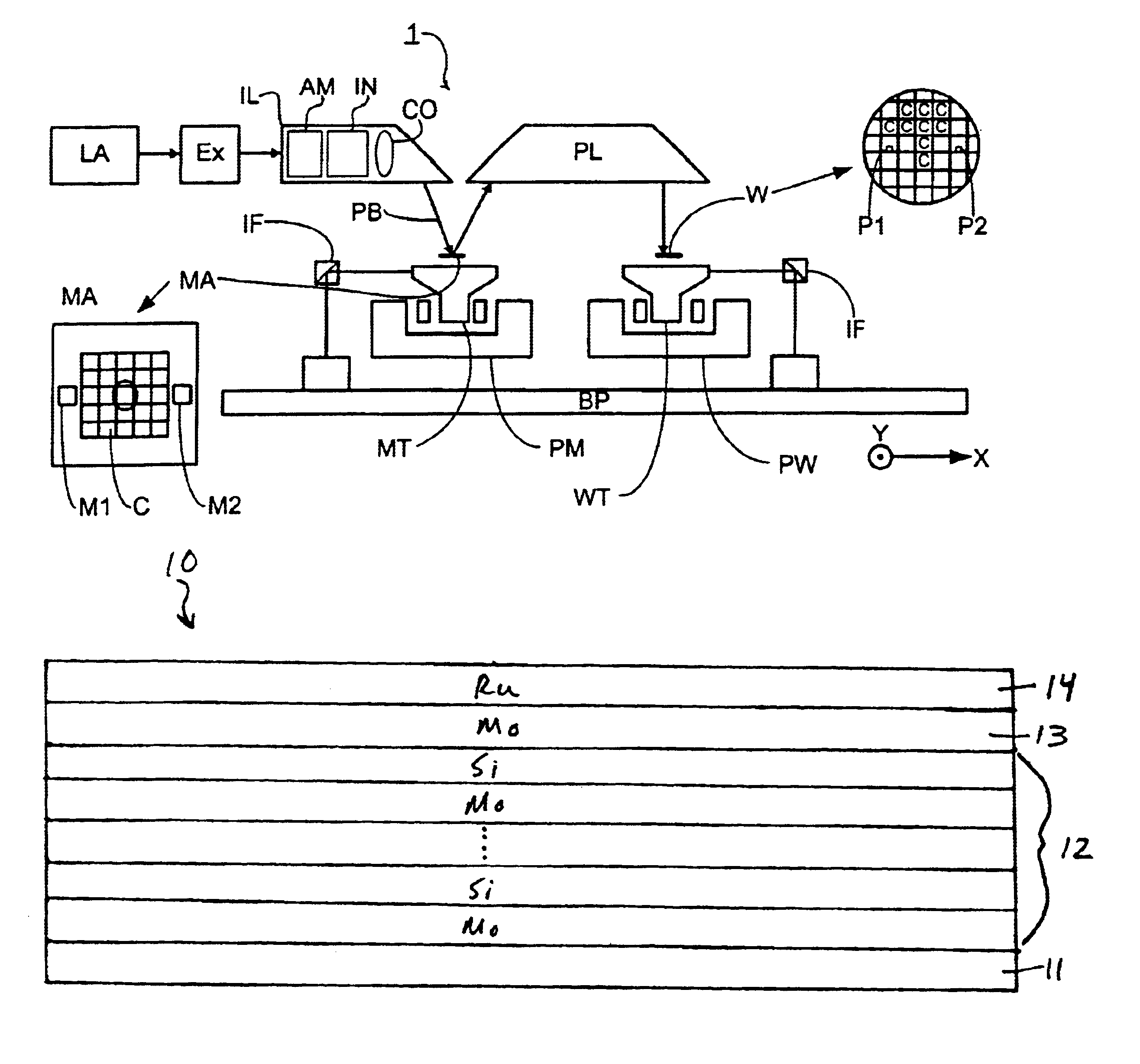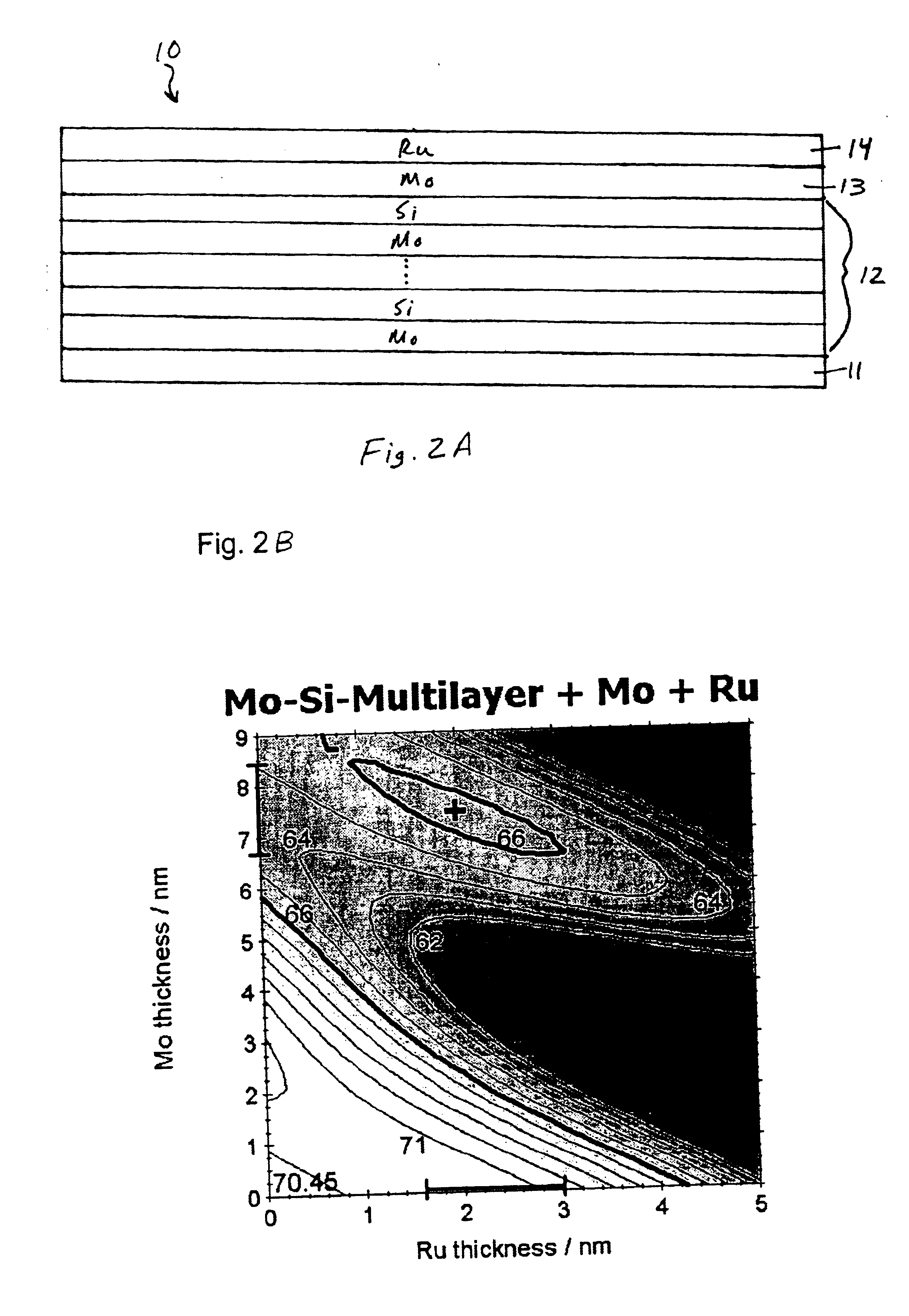Lithographic apparatus and device manufacturing method
a technology of lithographic projection and manufacturing method, which is applied in the direction of magnetic recording, record information storage, vacuum evaporation coating, etc., can solve the problems of significant decrease in reflectivity, and achieve the effect of improving resistance to oxidation and acceptable reflectivity
- Summary
- Abstract
- Description
- Claims
- Application Information
AI Technical Summary
Benefits of technology
Problems solved by technology
Method used
Image
Examples
first embodiment
[0044]As with the first embodiment, a second peak in reflectivity is apparent from FIG. 3B in the case where the interlayer 13A has a thickness of between 6.0 and 9.0 nm. The highest reflectivity is seen between 6.5 and 8.2 nm and more particularly between 7.0 and 7.8 nm. For the capping layer of Ru, the best reflectivity is between 1.6 and 3.0 nm.
[0045]For a larger thickness of the interlayer, a lower thickness of the capping layer is desirable, for example as low as 1.0 nm. For a lower thickness of the interlayer 13A of C a larger thickness of Ru capping layer 14 is desirable, up to about 3.0 nm. Preferably the Ru capping layer 14 has a thickness of between 1.6 and 3.0 nm, more preferably at least 2.0 nm.
[0046]Referring to FIGS. 4A and 4B, FIG. 4B shows the results of simulations calculating the theoretical reflectivity of a normal incidence optical element 10B according to the third embodiment of the present invention. The structure of the optical element 10B of the third embodim...
third embodiment
[0047]The results in FIG. 4B show a second peak of reflectivity in the same way that the results in FIGS. 2B and 3B also show a second peak in reflectivity. The second peak in reflectivity in the third embodiment occurs with an outer interlayer of C with a thickness of between 3.0 to 4.0 nm, for a capping layer of Ru with a thickness greater than about 2.0 nm, more preferably 2.2, and most preferably greater than about 2.4 nm. For a capping layer of Ru with a thickness of between 1.6 and 3.0, the best reflectivity is achieved with an outer interlayer of C of at least 3.4 nm, preferably greater than about 3.5 nm and most preferably greater than about 3.7 nm.
[0048]As can be seen from the examples, the second peak in reflectivity occurs when the interlayer thickness, i.e. the thickness of those layers positioned between the outermost Si layer in the Si / Mo multilayer structure and the capping layer, is about half the wavelength of the incident radiation, between 0.3 and 0.7, or between ...
PUM
| Property | Measurement | Unit |
|---|---|---|
| thickness | aaaaa | aaaaa |
| thickness | aaaaa | aaaaa |
| thickness | aaaaa | aaaaa |
Abstract
Description
Claims
Application Information
 Login to View More
Login to View More - R&D
- Intellectual Property
- Life Sciences
- Materials
- Tech Scout
- Unparalleled Data Quality
- Higher Quality Content
- 60% Fewer Hallucinations
Browse by: Latest US Patents, China's latest patents, Technical Efficacy Thesaurus, Application Domain, Technology Topic, Popular Technical Reports.
© 2025 PatSnap. All rights reserved.Legal|Privacy policy|Modern Slavery Act Transparency Statement|Sitemap|About US| Contact US: help@patsnap.com



